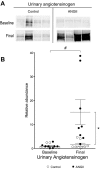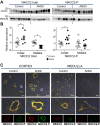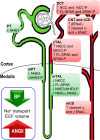Differential regulation of Na+ transporters along nephron during ANG II-dependent hypertension: distal stimulation counteracted by proximal inhibition
- PMID: 23720346
- PMCID: PMC3891260
- DOI: 10.1152/ajprenal.00183.2013
Differential regulation of Na+ transporters along nephron during ANG II-dependent hypertension: distal stimulation counteracted by proximal inhibition
Abstract
During angiotensin II (ANG II)-dependent hypertension, ANG II stimulates, while hypertension inhibits, Na(+) transporter activity to balance Na(+) output to input. This study tests the hypothesis that ANG II infusion activates Na(+) transporters in the distal nephron while inhibiting transporters along the proximal nephron. Male Sprague-Dawley rats were infused with ANG II (400 ng·kg(-1)·min(-1)) or vehicle for 2 wk. Kidneys were dissected (cortex vs. medulla) or fixed for immunohistochemistry (IHC). ANG II increased mean arterial pressure by 40 mmHg, urine Na(+) by 1.67-fold, and urine volume by 3-fold, evidence for hypertension and pressure natriuresis. Na(+) transporters' abundance and activation [assessed by phosphorylation (-P) or proteolytic cleavage] were measured by immunoblot. During ANG II infusion Na(+)/H(+) exchanger 3 (NHE3) abundance decreased in both cortex and medulla; Na-K-2Cl cotransporter 2 (NKCC2) decreased in medullary thick ascending loop of Henle (TALH) and increased, along with NKCC2-P, in cortical TALH; Na-Cl cotransporter (NCC) and NCC-P increased in the distal convoluted tubule; and epithelial Na(+) channel subunits and their cleaved forms were increased in both cortex and medulla. Like NKCC2, STE20/SPS1-related proline alanine-rich kinase (SPAK) and SPAK-P were decreased in medulla and increased in cortex. By IHC, during ANG II NHE3 remained localized to proximal tubule microvilli at lower abundance, and the differential regulation of NKCC2 and NKCC2-P in cortex versus medulla was evident. In summary, ANG II infusion increases Na(+) transporter abundance and activation from cortical TALH to medullary collecting duct while the hypertension drives a natriuresis response evident as decreased Na(+) transporter abundance and activation from proximal tubule through medullary TALH.
Keywords: ENaC; NCC; NHE3; NKCC2; SPAK; pressure natriuresis.
Figures









Similar articles
-
Short-term nonpressor angiotensin II infusion stimulates sodium transporters in proximal tubule and distal nephron.Physiol Rep. 2015 Sep;3(9):e12496. doi: 10.14814/phy2.12496. Physiol Rep. 2015. PMID: 26347505 Free PMC article.
-
Impact of angiotensin II-mediated stimulation of sodium transporters in the nephron assessed by computational modeling.Am J Physiol Renal Physiol. 2019 Dec 1;317(6):F1656-F1668. doi: 10.1152/ajprenal.00335.2019. Epub 2019 Oct 28. Am J Physiol Renal Physiol. 2019. PMID: 31657247 Free PMC article.
-
Angiotensin II hypertension along the female rat tubule: predicted impact on coupled transport of Na+ and K.Am J Physiol Renal Physiol. 2023 Dec 1;325(6):F733-F749. doi: 10.1152/ajprenal.00232.2023. Epub 2023 Oct 12. Am J Physiol Renal Physiol. 2023. PMID: 37823196 Free PMC article.
-
Effects of angiotensin II on kinase-mediated sodium and potassium transport in the distal nephron.Curr Opin Nephrol Hypertens. 2013 Jan;22(1):120-6. doi: 10.1097/MNH.0b013e32835b6551. Curr Opin Nephrol Hypertens. 2013. PMID: 23165113 Review.
-
Genetic and genomic evidence for an important role of the Na+/H+ exchanger 3 in blood pressure regulation and angiotensin II-induced hypertension.Physiol Genomics. 2019 Apr 1;51(4):97-108. doi: 10.1152/physiolgenomics.00122.2018. Epub 2019 Mar 8. Physiol Genomics. 2019. PMID: 30849009 Free PMC article. Review.
Cited by
-
Distal convoluted tubule.Compr Physiol. 2015 Jan;5(1):45-98. doi: 10.1002/cphy.c140002. Compr Physiol. 2015. PMID: 25589264 Free PMC article. Review.
-
Body mass-specific Na+-K+-ATPase activity in the medullary thick ascending limb: implications for species-dependent urine concentrating mechanisms.Am J Physiol Regul Integr Comp Physiol. 2018 Apr 1;314(4):R563-R573. doi: 10.1152/ajpregu.00289.2017. Epub 2018 Jan 3. Am J Physiol Regul Integr Comp Physiol. 2018. PMID: 29351422 Free PMC article.
-
Hypothesis: Unrecognized actions of ENaC blockade in improving refractory-resistant hypertension and residual cardiovascular risk.Int J Cardiol Hypertens. 2020 Sep 12;7:100048. doi: 10.1016/j.ijchy.2020.100048. eCollection 2020 Dec. Int J Cardiol Hypertens. 2020. PMID: 33447773 Free PMC article. No abstract available.
-
Cell-Specific Actions of the Prostaglandin E-Prostanoid Receptor 4 Attenuating Hypertension: A Dominant Role for Kidney Epithelial Cells Compared With Macrophages.J Am Heart Assoc. 2022 Oct 4;11(19):e026581. doi: 10.1161/JAHA.122.026581. Epub 2022 Sep 29. J Am Heart Assoc. 2022. PMID: 36172956 Free PMC article.
-
Potassium Supplementation Prevents Sodium Chloride Cotransporter Stimulation During Angiotensin II Hypertension.Hypertension. 2016 Oct;68(4):904-12. doi: 10.1161/HYPERTENSIONAHA.116.07389. Epub 2016 Sep 6. Hypertension. 2016. PMID: 27600183 Free PMC article.
References
-
- Alonso-Galicia M, Maier KG, Greene AS, Cowley AW, Jr, Roman RJ. Role of 20-hydroxyeicosatetraenoic acid in the renal and vasoconstrictor actions of angiotensin II. Am J Physiol Regul Integr Comp Physiol 283: R60–R68, 2002 - PubMed
-
- Banday AA, Lokhandwala MF. Oxidative stress causes renal angiotensin II type 1 receptor upregulation, Na+/H+ exchanger 3 overstimulation, and hypertension. Hypertension 57: 452–459, 2011 - PubMed
-
- Beutler KT, Masilamani S, Turban S, Nielsen J, Brooks HL, Ageloff S, Fenton RA, Packer RK, Knepper MA. Long-term regulation of ENaC expression in kidney by angiotensin II. Hypertension 41: 1143–1150, 2003 - PubMed
Publication types
MeSH terms
Substances
Grants and funding
LinkOut - more resources
Full Text Sources
Other Literature Sources
Medical
Miscellaneous

